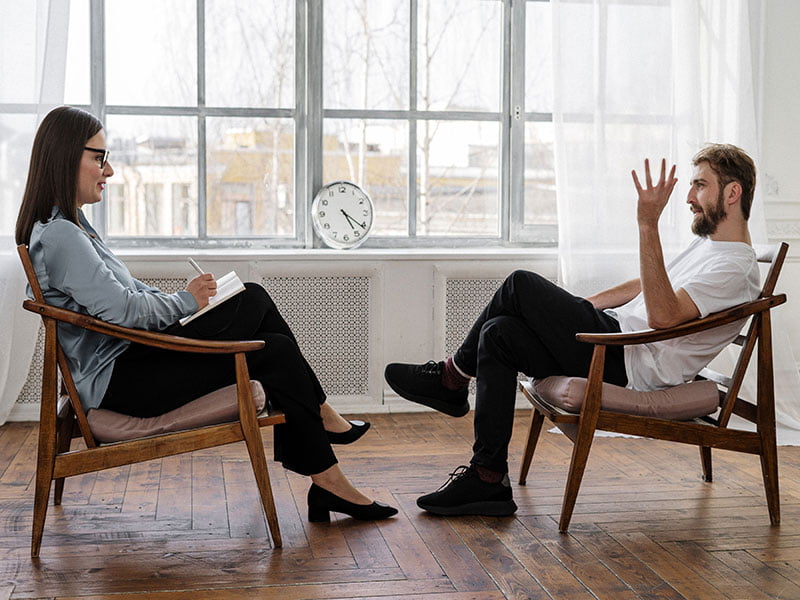Anxiety disorders are common, with Generalised Anxiety Disorder (GAD) “estimated to affect up to 5% of the UK population”. 1
Everyone experiences anxiety at different periods of their lives. Anxiety is part of the sympathetic nervous system and is a perfectly natural response to threats and dangers, as well as stressful life events such as changing schools or having a job interview. However, when that anxiety becomes significant, to the point of interfering with one’s ability to function normally, then it becomes a disorder.
There are different types of anxiety disorders, with a variety of triggers and because they share similar symptoms, it is easy to confuse them.
What are the common symptoms of anxiety disorders?
Symptoms include:
- Dizziness
- Dry mouth
- Excessive sweating
- Insomnia
- Palpitations
- Shortness of breath
- Stomach ache
- Tiredness
- Trembling or shaking
What are some of the anxiety disorders?
- Generalised anxiety disorder
A person with generalised anxiety disorder struggles with anxiety, worries or fears on a near constant basis. These aren’t limited to any one thing but branch out to include a variety of circumstances. As anxious thoughts are resolved, more anxious thoughts on a potentially different topic quickly arise. Sometimes a trigger for the anxiety may not be obvious, which can then further increase the anxiety.
- Panic disorder
A person with panic disorder feels extreme anxiety, stress, and panic at any time, often with no clear trigger. They usually experience multiple unexpected panic attacks when there is no danger, and they worry a lot about having future panic attacks.
A panic attack occurs with a feeling of intense fear and is accompanied by at least four of the following symptoms:
- a racing heartbeat
- feeling faint
- sweating
- nausea
- chest pain
- shortness of breath
- trembling
- hot flushes
- chills
- shaky limbs
- a choking sensation
- dizziness
- numbness or pins and needles
- dry mouth
- a need to go to the toilet
- ringing in your ears
- a feeling of dread or a fear of dying
- a churning stomach
- a tingling in your fingers
- feeling like you’re not connected to your body 2
- Phobias
“A phobia is an overwhelming and debilitating fear of an object, place, situation, feeling or animal.” 3
There are two main categories of phobias:
- Specific or simple phobias, which usually begin in childhood or adolescence and can become less severe with age.
- Complex phobias, which typically occur in adulthood.
Examples of simple phobias include:
- Animal phobias – snakes, dogs etc.
- Environmental phobias – deep water, heights etc.
- Situational phobias – flying, going to the doctor etc.
- Bodily phobias – blood, injections etc.
- Sexual phobias – anxiety regarding sexual performance, catching a sexually transmitted infection etc.
A common complex phobia is agoraphobia, which is more than a fear of open spaces. It includes feeling anxious about being trapped and unable to escape a place or situation if they have a panic attack. Using public transport, visiting a shopping centre, and leaving home can be quite difficult for the agoraphobic.
- Social anxiety disorder
Social anxiety disorder is more than simple shyness. A person struggling with social anxiety may have low self-esteem. They may think of themselves as ‘stupid’, ‘strange’, or ‘boring’.
They find it extremely difficult to be in social situations, or they avoid them altogether. Meeting strangers, initiating conversations, talking on the phone can all be a struggle. Before, during and after entering a social situation they worry excessively about things like being criticised or of appearing incompetent. Once they are out of the situation, they often believe it was awful.
To avoid drawing attention to themselves, and hide any visible signs of anxiety, they may avoid eye contact, wear a jacket to hide sweating, or wear makeup to hide blushing.
How is Anxiety Treated?
Psychological therapies are usually recommended first before medication is prescribed; however, medication can be prescribed first if the individual does not wish to try psychological therapies.
Exposure therapy is a form of cognitive behavioural therapy and is where an individual creates a fear hierarchy, making a list of triggers of their anxiety or phobia and places them in order of least anxiety provoking to the most anxiety provoking.
Exposure can be done either by using the imagination (in vitro) to expose themselves to their phobic triggers or they are exposed to the triggers in real life (in vivo).
- Graded exposure
In graded exposure the patient gradually works their way up the fear hierarchy, exposing themselves to their triggers, one step at a time, until they can manage their most feared object or situation.
- Systematic desensitisation
Systematic desensitisation takes the principles of graded exposure and combines them with relaxation. It works under the basis of classical conditioning and suggests the anxiety response in phobias is a learned response. The technique aims to replace the anxious response with a relaxed one.
The patient is given breathing and deep muscle relaxation exercises to practise until they can achieve a state of relaxation. They then create the fear hierarchy and practise the relaxation techniques as they are exposed to each item of the hierarchy. They do this until their anxiety response is sufficiently reduced, before proceeding to the next level. If at any time the level they are on becomes too overwhelming, the patient can return to the previous level until they are ready to try again. 4
- Flooding
This is where a patient will be exposed to the highest level of the fear hierarchy, rather than gradually being exposed to their triggers. This approach is usually considered if the fear is significantly impacting a person’s ability to live their life, but can be traumatic to experience. 5
Medication
Symptoms of anxiety can be treated with a variety of medications. Medications typically used for treating depression or epilepsy can also be beneficial for treating anxiety. Types of antidepressant medications include selective serotonin reuptake inhibitors (SSRIs) and serotonin and noradrenaline reuptake inhibitors (SNRIs). Benzodiazepines, a type of sedative, are typically used as a short-term treatment option.
Final Thoughts
If you suffer from one or more anxiety disorders, with symptoms ranging from mild anxiety to severe, can’t leave the house anxiety, living a fulfilling life can feel particularly challenging. But you don’t have to live like this forever; your symptoms can be managed, and, in time, you can live a happy, productive life.
Taking the initial step in seeking treatment can be overwhelming. Fear will try to stop you. But this is your life. Wouldn’t it feel better if you had the tools necessary to manage your symptoms? To live the life you want to live?
(1) https://www.nhs.uk/mental-health/conditions/generalised-anxiety-disorder/overview/
(2) https://www.nhs.uk/mental-health/conditions/panic-disorder/
(3) https://www.nhs.uk/mental-health/conditions/phobias/overview/
(4) https://www.simplypsychology.org/Systematic-Desensitisation.html
(5) https://www.verywellmind.com/exposure-therapy-definition-techniques-and-efficacy-5190514
Written by Hannah Telford
October 2021
Approved by Stephen Ilyas, Consultant Psychiatrist
November 2021






Leave A Comment